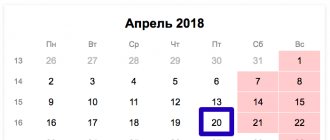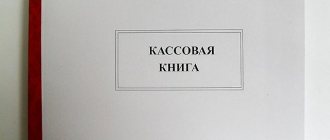What documents are needed for online checkout?
According to the Directives of the Bank of Russia dated March 11, 2014 No. 3210-U, all cash transactions are documented in the following documents:
- cash book;
- PKO - cash receipt order;
- RKO - expense cash order.
- Setting up an online cash register
2 reviews
1 000 ₽
1000
https://online-kassa.ru/kupit/nastrojka-onlajn-kassy/
OrderMore detailsIn stock
- Training to work on CCP
1 review
2 000 ₽
2000
https://online-kassa.ru/kupit/obuchenie-rabote-na-kkt/
OrderMore detailsIn stock
- Technical support for 3 months.
3 600 ₽
3600
https://online-kassa.ru/kupit/tehnicheskoe-soprovozhdenie-na-3-mes/
OrderMore detailsOut of stock
Features of the cash book for individual entrepreneurs and LLCs
For individual entrepreneurs there is no obligation to maintain a cash book. But at the same time, entrepreneurs must still keep records of income in it. However, if an entrepreneur already keeps or wants to keep a cash book, no one limits him, this is his right.
If an individual entrepreneur keeps a cash book, then the nuances of filling out will concern only the internal sheets. Thus, in the plate indicated on the sheets of the book, the column indicating the corresponding account is not filled in, unlike in organizations. Entrepreneurs do not indicate a cash balance limit.
It is also noteworthy that individual entrepreneurs do not issue so-called consumables - cash orders.
As for limited liability companies, the procedure is also slightly simplified; the following is not specified:
- correspondent account;
- there is no column defined as “sub-account”;
- analyst codes;
- special purpose.
However, the cash limit is still indicated.
Cash book for online cash register
The cash book keeps records of all amounts received and spent: revenue, cash issued, cash deposited at the bank.
Individual entrepreneurs maintain a cash book at will and can refuse it. But for companies, a cash book is required, even if there is an online cash register.
How to keep a cash book for online cash registers
According to the Decree of the State Statistics Committee of Russia dated August 18, 1998 No. 88, the cash book is kept in the KO-4 form. But the company can approve its form according to its accounting policies.
What does a cash book look like?
The cash book can be in 3 formats:
- paper;
- electronic with file printout;
- only electronic on PC.
The cash book on paper forms must be stitched and numbered. It is operated by a cashier throughout the working day. He fills it out, having received receipt and expenditure orders from the accounting department. They allow the cashier to receive and issue funds.
How to flash a cash book and its sample
In the electronic version, the cash book is also filled out by the cashier or a responsible person appointed by management. An electronic signature issued to an official in accordance with the law dated 04/06/11 No. 63-FZ is used for it.
The cash book is filled out only once a day when funds are posted to the company. For example, if salaries were issued through the cash register on May 1 and May 15, then the corresponding dates will be recorded in the book.
1. Ask our specialist a question at the end of the article. 2. Get detailed advice and a full description of the nuances! 3. Or find a ready-made answer in the comments of our readers.
If you don't keep records, the tax office may fine you. According to paragraph 1 of Art. 15.1 Code of Administrative Offenses of the Russian Federation:
- for organizations - a fine of 40–50 thousand rubles;
- for individual entrepreneurs and heads of companies - 4–5 thousand rubles.
Step-by-step cash book maintenance
Is it possible to make corrections to the cash book?
Yes, but only on paper forms. To make corrections, cross out the incorrect entry and enter the correct value. You cannot erase entries in the book. According to Instructions No. 3210-U, all corrections are certified by the cashier or chief accountant.
Corrections cannot be made to a book formatted and signed in electronic format.
How to correct an error in the cash book
How many cash books should be kept?
If you are an individual entrepreneur and optionally keep a cash book, then one is enough for you.
For organizations, the number of cash books depends on the number of branches, according to Directive No. 3210-U. If they are not there, then keep 1 book, even when combining tax regimes.
Basic rules for registering a cash book
- The cash book is started annually and is maintained from the beginning to the end of the year. If it ends before the end of the reporting period, a second cash book is drawn up, entries in which continue to be made in chronological order.
- You can fill it out either handwritten or on the computer. All information must be entered in order, without gaps.
- The cash book consists of two parts:
- title page where information about the company is entered,
- main pages where data on cash financial transactions carried out for each day is indicated.
- Each sheet has two copies, one of which, after filling out, must be left in the book, and the second must be cut off and handed over to the accounting department specialists. All sheets of the cash book should be numbered in the usual order and laced together. The number of sheets in the book should be written on the last page and this information must be certified by the signature of the chief accountant, the director of the enterprise and the seal (if any).
- It is impossible to make mistakes, blots and inaccuracies in the document, but if they do happen, you should cross out the incorrect information and carefully enter the correct information next to it. The correction must be certified by the signature of the cashier and the chief accountant. You can fill out the cash book only with a ballpoint pen (pencils are not allowed).
- The cash book must be maintained daily, but if no cash transactions were carried out on a particular day, there is no need to fill out the sheets. At the end of each work shift, the cashier is required to submit the document to the accounting department, along with the rest of the “primary” documents. After checking the information entered in it, the accountant signs the book and returns it to the cashier.
- One enterprise cannot have two cash books, except in cases where a legal entity has representative offices and branches - they must have their own similar documents (in this case, copies of the cash book and payment documents must be regularly transferred to the head office).
Cashier-operator journal for online cash register
The cashier-operator's journal is an optional form of filling out according to the letter of the Federal Tax Service of Russia dated September 26, 2016 No. ED-4-20 / [email protected] Because the data that was previously recorded in the journal is now sent to the Federal Tax Service online.
Why do you need a cashier-operator’s journal and who should have it?
The cashier-operator's journal is needed for the online cash register to take into account the receipt and expenditure of cash. Despite the fact that since July 2017 it is optional, it will be useful for internal accounting.
The log is kept by an employee who serves customers using cash registers. The document is kept by the manager or chief accountant.
If you still decide to conduct it, then read the instructions below.
Sample of filling out a cash book
[ads-pc-3] [ads-mob-3]
It includes a title page on which you need to fill in information about the name of the organization (full or abbreviated), OKPO code and structural unit.
There you also need to write down the period during which this register is drawn up. The loose leaf and the cashier's report differ only in their names; they are filled out in exactly the same way.
At the top of the document the current date is indicated, as well as the serial number of the sheet.
In the tabular part of the document, an entry is made about the balance of money in the cash register at the beginning of the day. It must correspond to the balance at the end of the previous day.
Next, the cashier, as transactions are completed, enters the data into the appropriate columns of the book. In the “Document number” column the number of the PKO or RKO is written down. In the next column you must indicate your full name. person or name of a legal entity and full name. his representative, who are either contributors or recipients of funds. In the “Corresponding account” column, fill in the corresponding code from the organization’s Chart of Accounts.
The columns “Incoming” and “Expense” indicate the amounts deposited or issued in rubles and kopecks. At the end of the day, the cashier calculates the totals of receipts and expenditures of funds and writes them in the “Total for the day” line. Then the cashier calculates the balance at the end of the day: the balance at the beginning plus receipts minus expenses.
After that, he checks the actual balance with the resulting one. The line “incl. for wages, payments" is filled in when wages or scholarships are paid, and reflects the balance of money in the cash register intended for wages.
Having completed the check, the cashier signs the report, folds and counts the documents. In the cash book, you must indicate in words the number of receipts and consumables per day. Then the documents are stapled and sent to the accounting department. After checking the cashier's report, the chief accountant puts his signature on it.
When an incoming and outgoing cash order is issued
Receipt cash order (PKO)
According to the resolution of the State Statistics Committee of Russia dated August 18, 1998 No. 88, a cash receipt order is issued when the company receives cash. The PKO consists of two parts:
- the order itself;
- tear-off receipt.
Cash receipt order form
The cashier enters the information and signs both parts of the document. You cannot correct a completed form.
Step-by-step algorithm for filling the PKO
Account cash warrant
According to Directive No. 3210-U, an expense cash order is issued when cash is issued from the cash register. You cannot make corrections to a completed form.
Account cash warrant
Step-by-step algorithm for filling out RKO
What is “Cash Book KO-4”
A cash book is a document that records the receipt and disbursement of cash at the company's cash desk. Filling out a cash book is mandatory for everyone, regardless of the organizational form and the applicable tax system. An exception is made for individual entrepreneurs who keep records of their income and expenses - they do not have to draw up cash receipts and expenditure documents, and, therefore, they do not need a cash book (clause 4.1 of Central Bank Directive No. 3210-U dated 03/11/2014).
The cash book is filled out (see sample below) on the current form of form No. KO-4, approved by Decree of the State Statistics Committee of the Russian Federation dated 08/18/1998 No. 88 (as amended on 05/03/2000). The paper form includes: cover, title page and pages of the cash book.
The procedure for maintaining a cash book is prescribed in Resolution No. 88 only in general terms; detailed instructions for filling it out have not been developed. Also, when filling out, you should be guided by the provisions of the Directive of the Central Bank of the Russian Federation No. 3210-U.
Let's summarize
- Until July 1, 2021, when working with cash registers, 9 unified documents were mandatory: KM-1 - KM-9. After the introduction of online cash registers, they are no longer needed, because the cash register system sends this data to the Federal Tax Service automatically via the Internet.
- The following are required for registration: cash book, incoming and outgoing cash order.
- Individual entrepreneurs keep a cash book at will, as well as a journal for the cashier-operator. These documents are useful for internal accounting.
- For companies, maintaining a cash book is mandatory, but the cashier-operator's journal is optional.
- Registration of cash receipts or expenditures without orders is prohibited.
Technical support of equipment. We will solve any problems!
Leave a request and receive a consultation within 5 minutes.
Rules of conduct
The procedure for maintaining a cash book in an updated version has existed since 2014 in accordance with the instructions of the Central Bank. This instruction establishes a new format for carrying out cash transactions, however, the appearance of the document remains the same.
Maintaining a cash book depends on the format of its existence.
As you know, today it is possible to maintain a cash book in two versions:
- printed (filled out by hand);
- electronic (automated version).
Rules for filling out a printed cash book:
- The forms are the same for everyone and have a prescribed form. There cannot be any “special” cash book at the enterprise that would differ from that established by law. This is due to the simplification of the registration procedure for the enterprises themselves. Unification simplifies accounting and helps achieve a single and clear result.
- The cash book is drawn up every year , that is, the reporting period showing cash flow in the enterprise is equal to a calendar year.
- As for filling out, each sheet is numbered. Skipping pages is not allowed. All pages of the book are stitched together, the total number of numbered sheets is indicated at the end, the book itself is sealed with the signature of the head and the seal of the organization.
- The cashier keeps entries in duplicate in a hand-written book. This is due to the fact that one copy is an element of the cash book, and the second is an element of the report to the accounting department. Every cashier must avoid corrections, errors and any blots.
Rules for filling out the electronic cash book:
- In practice, there are minor differences between a printed manual and an e-book , but certain nuances still exist. A book issued in electronic form is printed to have a tangible appearance.
- At the end of the year, like a “handmade” book, it is signed and sealed. The cover is also printed at the end of the year.
- If the enterprise maintains an electronic cash register, quarterly registration of the cash book is allowed. Unlike the handwritten version, in which the second copy is cut along the corresponding vertical line, e-books are cut horizontally, and the second version is also a cashier's report.
- The cashier is required to make entries daily , indicating at the beginning of the working day the balance in the account, and at the end of the day, after taking into account the transactions carried out for the day, the total for the day, where he records the amount deposited in the cash register, as well as waste. Every transaction carried out during the day must be reflected in the ledger.
How to fill out a cash book
So, you have a cash book, how to manage 2021? The process follows this pattern. The cashier must be responsible for the cash register (clause 4, clause 4.6, clause 4 of Instructions No. 3210-U). If there is no cashier position in the institution, another accounting employee, who is indicated directly by the head in the relevant order, is responsible for maintaining the cash book. The control function remains with the chief accountant. Each organization actually regulates the cash flow process itself. In budgetary institutions where there is a constant flow of funds, a cash book must be present. Maintaining a cash book in 2021 can be reflected in the following generalized diagram:
- The cashier collects balances daily at the beginning and end of the working day. These amounts must be equal. If no operations were performed on any day, the arch need not be formed. The balance will automatically be transferred to the next day.
- The arrival (receipt) of funds is registered with a cash receipt order, cash issuance is carried out through expenditure orders. Numbers for each of these documents are assigned in order, and information about them is reflected in the cash book.
- On days when there was cash movement, the cashier will complete his work by summing up the results of the billing period. The book reflects all daily transactions and is certified by the signature of the responsible employee. All movements and their entries in the cash book must be submitted to the chief accountant for verification.
Here is a printed view of the cash book. The OKUD form code is 0310004. Essentially, this is an empty cash book; a sample of filling it out manually can be found at the end of the article.
This is what the cash book form looks like, you can download the word for free.







